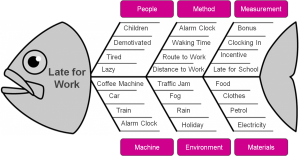 When I was a Young Lad – about 25 – I was hired by a company ERI Bancaire, SA. They were in Geneva. A small start-up company. Running things as a good company would. But they needed structure & marketing. They hired me for that.
When I was a Young Lad – about 25 – I was hired by a company ERI Bancaire, SA. They were in Geneva. A small start-up company. Running things as a good company would. But they needed structure & marketing. They hired me for that.
I got interested in Quality Assurance. I learned the key concepts – like Total Quality Assurance, Continuous Improvement, the House of Quality. Interesting concepts to improve. A Person can also use Quality Techniques to improve themselves.
In Quality Circles, people get together, not to place blame, but to discuss ways to improve the procedures of the company.
I came up with 4 questions – which involve using some of the Quality Tools – like Brainstorming and the Fishbone / Casue & Effect Diagram.
The 4 Problem Solving Questions:
- What is the Problem?
- What are the main Causes of the Problem?
- What are the Best Possible Solutions?
- How Can we Implement Them?
The First part involves getting the people involved who know the most or are most concerned about the problem or concern. This is called a Quality Circle. The First Step is to Decide by Consensus, the exact problem. The more precisely it is worded the more accurate solution. Remember to assure that the problem is the real problem – not just a symptom of a greater problem. Like people are coming late, might be a symptom of low moral. Or it might be a problem in itself.
Step 2 is to Brainstorm all of the causes. No idea is criticized. It is just to generate ideas. Not to evaluate. Even if some ideas are a bit off the wall, write them down on the board.
After causes are exhausted. These causes are then placed on a Fishbone or Cause & Effect Diagram. The Fishbone Diagram is looks like box with a horizontal line attached. Attached to the line are other lines that are the major categories of causes. Like “Material, Methods, Machinery, Manpower, Environment, Mindset & Miscellaneous.” You Choose the subcategories of causes. Useful software for making a fishbone diagram is called “Mind-map” Software.

Then discuss by consensus (or vote) what are the major causes. Remember the 80/20 rule also called the Pareto Rule. 80 percent of wealth is in hands of 20 percent of individuals. Or 80 percent of problems come from 20 percent of causes.
The next step is to find solutions to the Causes. Each cause is taken and discussed to find the best possible solution. One Can brainstorm for solutions or decide by consensus or do both. The Idea is to determine what, why where, who, when, & how.
One of the reasons that the Japanese have been successful in their quality campaigns is because their decisions by consensus. It takes more time than a vote, but ultimately a more thought out solution is made. The kinks and considerations are worked out in the discussion rather than after the product or service is implemented. Thus it might make more sense for a person to take the time in the beginning to iron out the details, than to have a detail or error produced and reproduced once it the product is manufactured.
It is more costly to catch an error after it is manufactured than to do so on the drawing board.
The last step is to implement the solutions. People have to be given responsibility and accountability. There should be methods to measure the effectiveness of any solution that is implemented.
There are many Quality Assurance Tools to use to Find solutions. You just have to find the right ones for you. Some include:
Quality Circles – Meetings to solve management, manufacturing, service quality concerns.
Fishbone or Cause & Effect Diagram – which helps to pinpoint causes of problems;
Brainstorming – to Generate Ideas;
House of Quality – used to find relationships between aspects of quality;
Software Quality Assurance Tools – which include endurance (hacker) testing;
Pareto’s Rule – which says that 80% of wealth is found in 20% of individuals – that applies to quality concepts;
Statistical Process Control – which analyzes statistically implementation of quality solutions;,
Force-Field Analysis – Analyzes forces that are working towards a positive outcome and forces against them.
Shewart Cycle, PDCA (plan–do–check–act or plan–do–check–adjust) is an iterative four-step management method used for the control and continual improvement of processes and products. Also known as the Deming circle/cycle/wheel, Shewhart cycle, control circle/cycle, or plan–do–study–act (PDSA).
Many tools are at the disposal of a business. The smart manager uses them to find solutions, avoid finding the person to blame. The smart person can use them to improve themselves.
A problem is sometimes an opportunity in disguise.
Using quality tools and involving others in decisions also have another advantage. People are given responsibility & importance that will help them to be more motivated – as seen in the Theodore Herzberg Motivation Theory – which states people are more motivated when you give them more responsibility, opportunities for achievement and appreciation.
Obviously, we must make our effort to solve problems. Our diligent efforts combined with Sincere & Precise Prayer to G-d / Hash-m will help you to find the best solution and solve problems. Hash-m has all the answers.
==
Keywords: #motivation #fishbone #solutions #qualitytechniques #selfhelp #totalqualityassurance #houseofquality #brainstorming #qualitycircles #paretorule #pdsacycle #forcefieldanalysis #consensus
